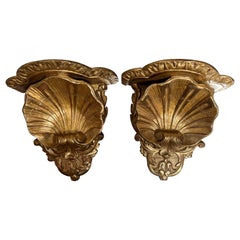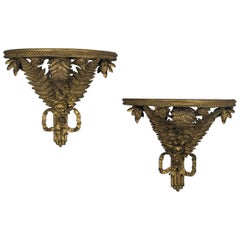Milan - Delft and Faience
3
to
541
436
3
3
3
1
1
1
2
1
1
3
2
2
3
3
1
1
Item Ships From: Milan
Art Nouveau Italian Pair of Wall Brackets with Children Busts and Flowers 1920
Located in Milan, IT
Pair of 20th century Art Nouveau Italian wall brackets, two hand-modeled, hand painted ceramic brackets with a fine polychrome decoration with half-bust girl and boy figures and flowers.
They are a Northern Italy manufacture, unmarked, dating back to the early 20th century in good condition, with minor chips consistent with age and use.
A very charming pair of Italian ceramic brackets showing, in the lower part an unusual flower composition surmounted by two half-bust figures, girl and boy with a fine polychrome decoration.
Ready to be hanged, this pair of antique wall brackets...
Category
Early 20th Century Italian Art Nouveau Milan - Delft and Faience
Materials
Ceramic
Four Italian Ancient Dishes, Lodi, circa 1770-1780
By Antonio Ferretti
Located in Milano, IT
Assortment of 4 dishes with braided rim
Antonio Ferretti Manufacture
Lodi, circa 1770-1780
Maiolica polychrome decorated “a piccolo fuoco” (third fire).
Measures: 14 x 10 in (35.5 x 25.5 cm);
12.2 x 8.39 in (31 x 21.3 cm);
10.4 x 9.65 in (26.5 x 24.5 cm);
10.8 x 9.61 in (27.5 x 24.4 cm).
Weight: 4.4 lb (1.998 kg)
State of conservation: some chips due to use on the edges and on the parts in relief.
The four different dishes have a foot with a low lip from which extends a wide, flat, slanted rim resembling a basket weave. The small handles are painted green: they resemble wickerwork in the two oval dishes and take the form of a sinuous branch in the round ones.
The third fire decoration is inspired by the naturalistic floral botanical patterns on the ceramics produced by the Hannong family in Strasbourg. Here the pattern is defined by the rapidity and subtlety of the brushstrokes and the result is particularly tasteful, characterized by compositional intelligence and pictorial expertise.
A main corolla, either a wild or garden rose, is set slightly off center in each well. From this extends a thin stem holding a small secondary bud and there are small field florets dotting the composition to lend volume to the delicate bunch of flowers.
On the brim, small polychrome flowers add color to the weave, accompanied by lanceolate leaves of a very intense green.
There exist few and very rare examples for comparison with this morphology: a round plate - entirely consistent with those in question - has been dated to around 1775 (S. Levy, Maioliche settecentesche lombarde e venete, Milano 1962, tav. 200). Two other dishes with a basket rim, but with parallel striped brim decoration, were exhibited in the 1995 exhibition on Lodi ceramics; the attribution to the Lombard town near Milan is therefore almost exclusively derived from the decoration called "alla rosa contornata" or "alla vecchia Lodi" and constitutes one of the most popular decorations during the eighteenth century. (M. L. Gelmini, in Maioliche lodigiane del '700 (cat. mostra Lodi), Milano 1995, pp. 31 p. 162-163 nn. 181-182).
This decorative choice represented a strong point of the Lodi factory, which established itself thanks to the vivid nature of the colors made possible by the introduction of a new technique perfected by Paul Hannong in Strasbourg and which Antonio Ferretti introduced in Italy. This production process, called “piccolo fuoco” (third fire), allowed the use of a greater number of colors than in the past; in particular, the purple of Cassius, a red made from gold chloride, was introduced. Its use allowed for many more tones and shades, from pink to purple.
The Ferretti family had started their Maiolica manufacturing business in Lodi in 1725.
The forefather Simpliciano had started the business by purchasing an ancient furnace in 1725 and, indeed, we have evidence of the full activity of the furnaces from April of the same year (Novasconi-Ferrari-Corvi, 1964, p. 26 n. 4). Simpliciano had started a production of excellence also thanks to the ownership of clay quarries in Stradella, not far from Pavia. The production was so successful that in 1726 a decree of the Turin Chamber came to prohibit the importation of foreign ceramics, especially from Lodi, to protect internal production (G. Lise, La ceramica a Lodi, Lodi 1981, p. 59).
In its initial stages, the manufacture produced maolicas painted with the “a gran fuoco” (double fire) technique, often in turquoise monochrome, with ornamentation derived from compositional modules in vogue in Rouen in France. This was also thanks to the collaboration of painters like Giorgio Giacinto Rossetti, who placed his name on the best specimens next to the initials of the factory.
In 1748 Simpliciano made his will (Gelmini, 1995, p. 30) appointing his son Giuseppe Antonio (known as Antonio) as universal heir. After 1750, when Simpliciano passed away, Antonio was directly involved in the Maiolica factory, increasing its fortunes and achieving a reputation on a European level. Particularly important was the aforementioned introduction in 1760 of the innovative “a piccolo fuoco” (third fire) processing, which, expanding the ornamental repertoire with Saxon-inspired floral themes, could commercially compete with the German porcelains that had one of its most renowned offerings in the naturalistic Deutsche Blumen. Antonio Ferretti understood and promoted this technique and this decoration, proposing it in a fresher and more corrective version, less linked to botanical tables...
Category
1770s Italian Neoclassical Antique Milan - Delft and Faience
Materials
Maiolica
Ancient Maiolica Plates Pasquale Rubati, Milan Circa 1770-1780
By Pasquale Rubati
Located in Milano, IT
Five oval maiolica dishes with pierced edge
Manufacture of Pasquale Rubati
Milan, 1770-1780
Three small oval dishes 10.23 in x 7.67 in (26 cm x 19.5 cm)
Two large oval dishes 10.82 in x 8.85 in (27.5 x 22.5 cm)
lb 3.5 (kg 1.8)
State of conservation: intact
The five dishes of different sizes have an oval shape, a mixtilinear edge and a molded polylobed shape with a surface enriched with a relief weave motif extending to the brim and forming a perforated basket...
Category
1770s Italian Rococo Antique Milan - Delft and Faience
Materials
Maiolica
Related Items
Pair of French Gilt Wall Brackets
Located in Dallas, TX
A pair of French Gilt wood and plaster wall brackets in the rococo style with a large clam shell. They are burnished with a wonderful old patina and sheen.
Category
Late 19th Century French Rococo Antique Milan - Delft and Faience
Materials
Wire
Pair of Fern Wall Brackets
Located in New York, NY
American, circa 1850-1880.
Eastern white pine (Pinus strobus), with wire armature and composition ornament, gessoed
and gilded.
Measures: 14 1/8 in. high, 16 5/16 in. wide (at the sh...
Category
19th Century American Aesthetic Movement Antique Milan - Delft and Faience
Materials
Wood
19th Century English Minton Bombay Flow Blue Oyster Plate
By Minton
Located in Winter Park, FL
A Victorian Minton flow blue porcelain oyster plate, with six oyster wells, a center well and a large well for crackers. Decorated in the Japonisme...
Category
Late 19th Century English Japonisme Antique Milan - Delft and Faience
Materials
Faience, Ceramic
19th Century English Majolica Oyster Plate Signed Minton
By Minton
Located in Winter Park, FL
A good English Majolica plate, dated 1885 and marked Minton, with turquoise and cobalt blue oyster plate with a central well surrounded by small ochre flowers. Six small and one larg...
Category
Late 19th Century English Late Victorian Antique Milan - Delft and Faience
Materials
Majolica
Blue and White Delft Dishes Antique Pair Made circa 1770
Located in Katonah, NY
We are pleased to offer this pair of blue and white Dutch Delft dishes with lovely chinoiserie decoration, which features an image of a vase overflowing with flowers.
Around the vas...
Category
1770s Dutch Chinoiserie Antique Milan - Delft and Faience
Materials
Delft
French Faience Dishes or Plates Made circa 1780
Located in Katonah, NY
We are pleased to offer these two 18th century French faience dishes painted with figures. The first plate, mustard yellow on a white ground, fea...
Category
1780s French Chinoiserie Antique Milan - Delft and Faience
Materials
Faience
Blue and white plate with deer in a landscape Delft, circa 1700
By Delft
Located in ROSSUM, GE
Blue and white plate with deer in a landscape Delft, circa 1700
The plate has a narrow, flat flange and is painted in blue with a landscape with four deer between trees. Birds fly ...
Category
Early 18th Century Dutch Baroque Antique Milan - Delft and Faience
Materials
Ceramic, Faience
Early Wedgwood Neoclassical Creamware Dessert Dishes Made circa 1780
By Wedgwood
Located in Fort Lauderdale, FL
A set of four early Wedgwood creamware Neoclassical dessert dishes made circa 1780.
Sir William Hamilton’s Collection of Etruscan, Greek and Roman an...
Category
Late 18th Century English Neoclassical Antique Milan - Delft and Faience
Materials
Creamware
Dutch Delft Hand Painted Plate or Dish Late 18th Century Circa 1780
Located in Katonah, NY
The center of this hand painted Dutch Delft plate shows a lovely garden with a pine tree and a large peony.
The scene continues onto the border, where we see three butterflies and mo...
Category
Late 18th Century Rococo Antique Milan - Delft and Faience
Materials
Delft
Ceretto Sannita - maiolica plate 18th century
By Nove, Italy
Located in DELFT, NL
A maiolica plate, most likely Cerreto Sannita. Floral decor
unmarked.
Italy, late 18th century. Dimensions: diam. 24 cm.
Good condition: light chipping and some usual wear to the...
Category
18th Century French Chinoiserie Antique Milan - Delft and Faience
Materials
Earthenware, Faience, Maiolica
Set of Five Faience Knife Rests Desvres, circa 1890
By Desvres
Located in Austin, TX
Set of five knife rests signed Desvres, circa 1890.
Colorful with coat of arms and acanthus leaves.
Category
1890s French Country Antique Milan - Delft and Faience
Materials
Faience
Pair Italian Painted Wood Wall Brackets
Located in Douglas Manor, NY
1550 Italian pair painted wood wall brackets with crackel and gilt finish
Category
1970s Vintage Milan - Delft and Faience
Materials
Hardwood
Recently Viewed
View AllMore Ways To Browse
Delft Tile Antique
Antique Delft Tile
Antique Delft Tiles Tiles
Antique Delft Tiles
Delft Antique Tiles
Delft Tiles Antique
Delft Tile Antique Tiles
Delft Panel
Delft Blue And White Chargers
Vintage Delft
Delft Plates Holland
Retro Blue Delft
Blue White Delft Plate
Antique Kitchen Tile
Delft Blue And White Plates
Dutch Delft Charger
Blue And White Faience Pots
Dutch Delftware

